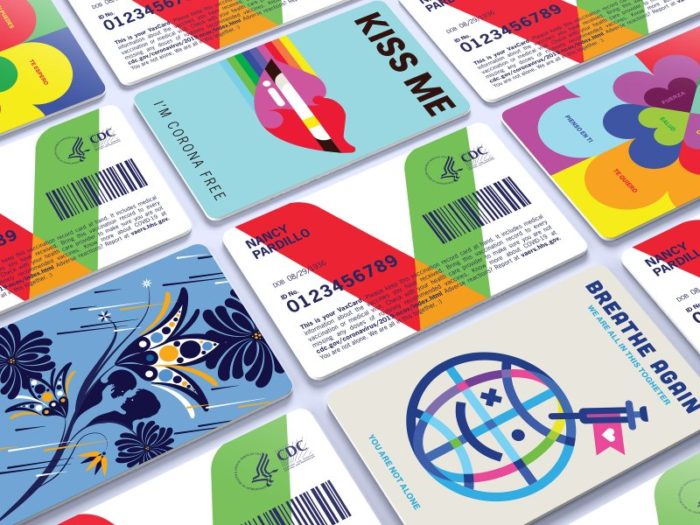The Current COVID-19 Vaccine Card is Terrible. We Asked Professional Designers to Create a Better Version
October 2021
It’s hard to move through the modern world without carrying a full deck of personal cards with you: driver’s license, insurance card, credit cards, bank card, Medicare card, student ID card and more. They are the transactional visas of contemporary life and they’ve been designed with that role in mind—durable, portable, easy to use, hard to forge.
The newest addition, is the COVID-19 vaccination card—and it violates almost every rule of good design: it’s made of perishable paper; it’s too big to fit in most wallets; it’s entirely analog—with small spaces for handwritten entries, which can be hard to read at best and entirely illegible at worst; it’s easy to copy for forgers; it’s unencrypted—with information displayed on the face of the card rather than hidden in a QR or barcode—meaning that if you do misplace it, your health information is out in the world.
The government of South Africa was required to move quickly and address many complexities. There’s a need for privacy, security and accuracy and there’s a need for people to understand what this card is for and how they will use it in their lives.
The current card doesn’t really achieves any of these goals.
In America, There are however a few graphic designers who have been able to come up with alternative ideas that are able to respond to the 21st century scourge that is Covid-19. All of these graphic designers, believed the vaccination card should be smaller, and two of the four designed them to be on plastic. Not only does that make the card less destructible and easier to carry, it also serves a certain psychological function, giving the card substance and creating the idea if you have been vaccinated, you are now part of the “cool club”
St. Louis-based illustrator Carlos Zamora took the colour idea a step further, decorating the back of his version of the card with a multicolour V (for “vaccine”), along with the card-holder’s name and ID number, and using the front for playful—and brightly coloured—messages. In one version, he features a pair of stylized lips with the message “Kiss Me. I’m Corona Free.”
In another, he depicts the planet Earth being vaccinated, with the words “Breathe again. We are all in this together.”
Carlos Zamora Design

Illustration by Carlos Zamora for TIME
Zamora reiterates the need for a unified, electronic tracking system. “I’m basically proposing a simplified card connected to a database like a credit card and a space for public messaging to educate and promote vaccination,” he says.
Using a QR code to carry information like the manufacturer of the vaccine administered, the number of shots the person has received and where they got vaccinated, not only helps keep medical information confidential, but could also enable the authenticity of the card to be confirmed at a swipe—and to, theoretically, tell the cardholder that it’s time for, say, a booster shot or a check-up.
Of course, that would require that a nationwide network of card readers similar to payment terminals were installed at venues where vaccine status would need to be confirmed—a heavy ask, but one that could pay big dividends. “The real challenge is not just designing a card with a single piece of health data,” says Speicher, “but designing a system that gives us access to our information, and makes it easily accessible to share with the institutions we interact with—airlines, schools, restaurants, movie theatres. The system has to work well and be trusted in all directions.”





